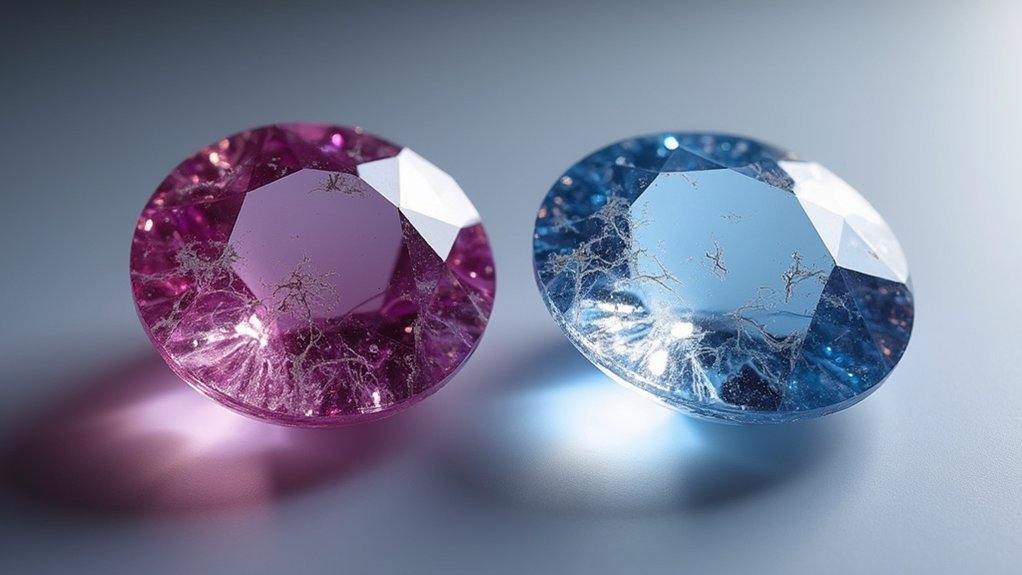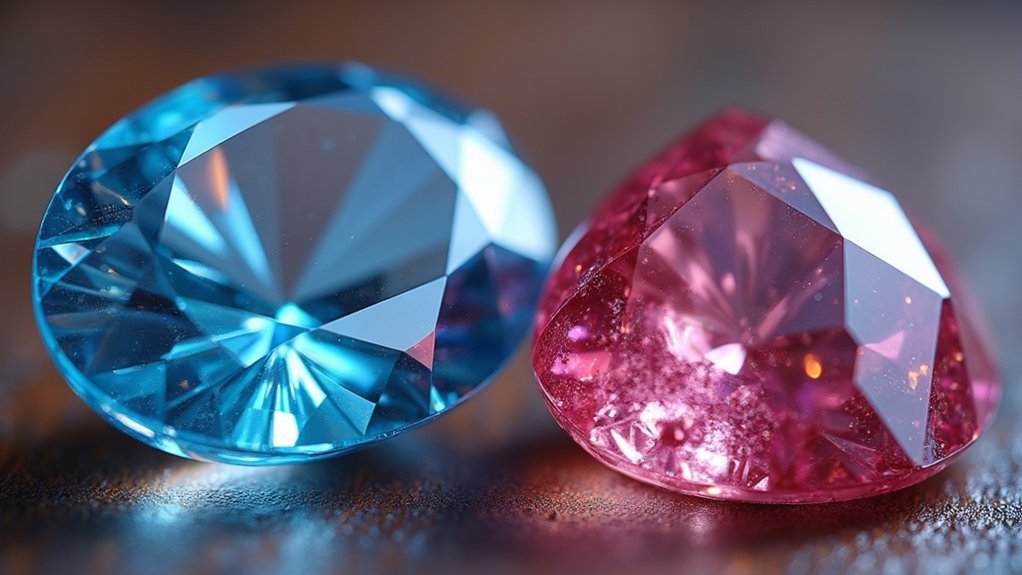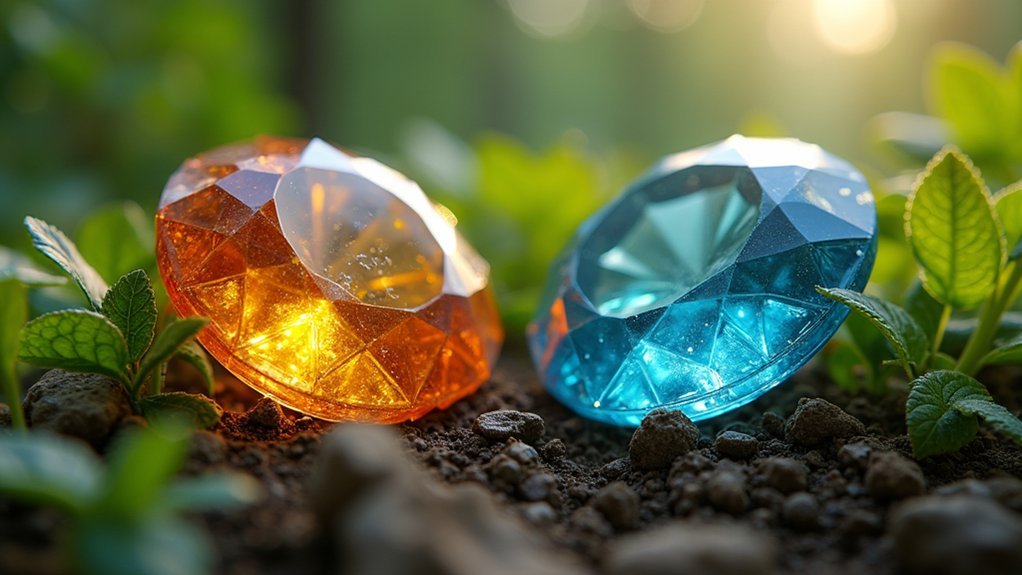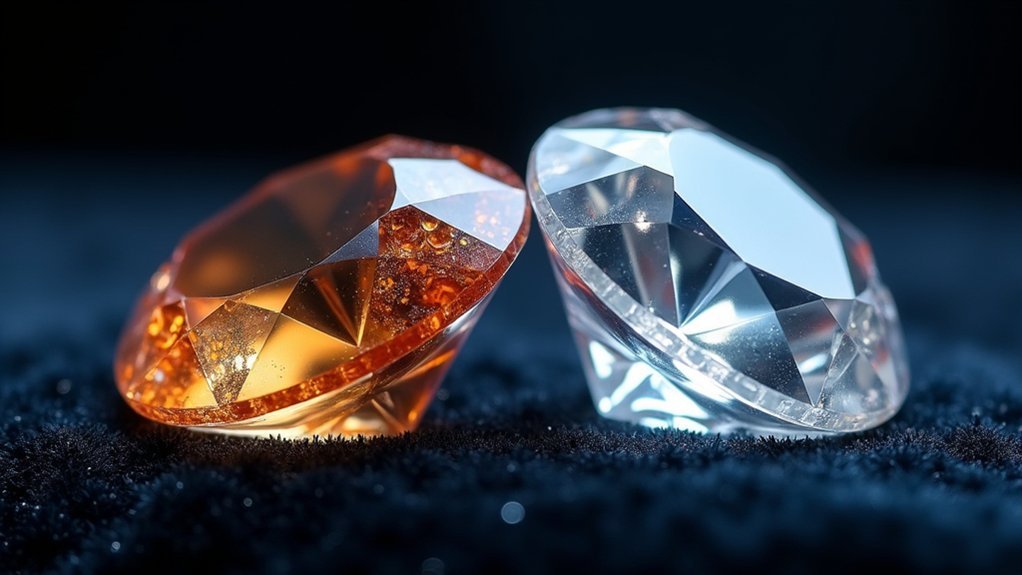Synthetic gems differ from natural ones primarily in their formation process—labs create synthetics in weeks, while nature takes millions of years. You’ll notice synthetics have fewer flaws, more uniform color, and perfect crystal structures compared to natural gems’ unique inclusions and character. Though chemically identical, synthetics cost considerably less but don’t retain value like natural stones. The environmental and ethical implications of your choice extend beyond just appearance and price.
10 Second-Level Headings for “Why Synthetics Differ From Natural Gems?”

When exploring the key differences between synthetic and natural gems, several distinct categories emerge that help consumers understand what sets these materials apart.
You’ll find that formation processes constitute a fundamental distinction, as synthetic gemstones develop in controlled lab environments while natural gemstones require millions of years to form underground.
Price and value represent another vital heading, highlighting how synthetics cost 10-100 times less than their natural counterparts.
Synthetics deliver identical beauty at a fraction of the cost—typically 10-100 times less than mined gems.
Visual characteristics deserve separate attention, as synthetics typically display fewer inclusions and more vivid colors. Though identical in chemical composition, these gems differ greatly in investment potential, with natural gems appreciating over time while synthetics depreciate.
Finally, ethical considerations warrant discussion, balancing mining concerns against resource-intensive laboratory processes that create these perfect but identifiable alternatives.
The Formation Process: Laboratory vs. Geological Creation
Although both share the same chemical properties, synthetic and natural gemstones emerge from drastically different formation processes that shape their ultimate appearance and value.
While natural gemstones develop through geological processes spanning millions of years—accumulating distinctive inclusions and color variations along the way—synthetic gemstones are crafted in controlled laboratory environments in mere weeks or months.
You’ll find techniques like Flame Fusion and Flux Growth replicating nature’s work at accelerated rates, creating synthetic gems with fewer imperfections and more vibrant colors.
These lab methods require significant energy to achieve the high temperatures and pressures needed, but they produce stones with consistent quality and clarity. The absence of natural imperfections in synthetic gemstones makes them visually distinguishable from their earth-formed counterparts, despite identical chemical compositions.
Physical and Chemical Composition Differences

You’ll notice synthetic gemstones typically display perfect crystal structures, while natural gems often contain characteristic irregularities due to their geological formation processes.
When examined under magnification, synthetic gems reveal distinctive growth patterns like curved striae or chevron patterns that aren’t present in their natural counterparts.
The inclusion formation process also differs considerably, with lab-created stones featuring fewer or more uniform inclusions compared to natural gems’ unique “fingerprints” that developed over millions of years.
Crystal Structure Variations
The fundamental distinction between synthetic and natural gemstones lies in their crystal structure development, despite sharing identical chemical compositions.
When you examine synthetic gemstones under microscopic analysis, you’ll notice their remarkably uniform crystal structure with fewer imperfections. This controlled laboratory creation allows for precise atomic arrangement that natural gemstones, formed over millions of years in unpredictable environments, simply can’t match.
You’ll find that natural gemstones typically display inclusions and color variations—telltale signs of their prolonged formation process.
In contrast, synthetics offer more consistent crystal lattices, resulting in enhanced optical properties like superior light dispersion and clarity. Specific manufacturing methods such as Flame Fusion or Flux Growth create distinctive structural characteristics that gemologists can identify with specialized tools.
These differences explain why you’ll often observe more vibrant colors and brilliance in lab-created gems.
Growth Pattern Distinctions
When examining growth patterns of gemstones, synthetic and natural varieties reveal their most telling differences despite their identical chemical compositions.
You’ll notice that synthetic gemstones display highly uniform growth patterns due to their controlled laboratory creation, while natural gems develop randomly over millions of years under varying geological conditions.
Under magnification, you can spot consistent, repetitive patterns in synthetics, contrasting sharply with the chaotic arrangement in natural stones. Natural gems typically contain distinctive inclusions—gas bubbles, minerals, or other imperfections—that serve as their geological fingerprints.
These inclusions are rare in synthetics, which typically boast higher clarity and more vivid coloration.
The growth rate difference is also remarkable—synthetic gems can form in weeks, while natural ones require millions of years to develop their unique characteristics.
Inclusion Formation Processes
Despite sharing identical chemical compositions, natural and synthetic gemstones develop fundamentally different inclusion patterns that reveal their distinct origins.
You’ll find these microscopic features tell compelling stories about how each gem came to be.
Natural gemstones contain inclusions that developed over millions of years through:
- Geological pressure creating mineral deposits trapped within the crystal structure
- Fluid interactions leaving behind liquid or gas bubbles as geological evidence
- Temperature fluctuations causing distinctive growth patterns unique to earth environments
- Mineral intrusions from surrounding rock formations becoming embedded during formation
In contrast, synthetic gemstones display laboratory-specific inclusions resulting from controlled manufacturing environments.
Their growth patterns often show distinctive lines or patterns characteristic of Flame Fusion or Flux Growth methods—telltale signs that help gemologists differentiate them from their natural counterparts.
Visual Characteristics and Clarity Variations

While both synthetic and natural gemstones can dazzle the eye, they differ considerably in their visual presentation.
When you examine synthetic gemstones, you’ll notice their almost too-perfect appearance—they typically showcase richer colors and higher clarity than their natural counterparts due to controlled lab conditions that minimize inclusions.
Natural gems tell a different story. They’ve developed over millions of years, acquiring unique inclusions and color variations that give them character and authenticity.
These “birthmarks” are actually prized by collectors and gemologists as proof of natural origin.
The clarity variations between the two are striking: synthetics often display a flawless, uniform brilliance that can appear artificial to trained eyes, while natural stones exhibit a depth and individuality that’s impossible to replicate in a laboratory.
Price Points and Market Value Comparison
The visual perfection of synthetic gems may catch your eye, but it’s their price tags that often seal the deal for budget-conscious shoppers. You’ll find synthetic gemstones cost dramatically less—sometimes just 1-10% of their natural counterparts—while often featuring superior clarity.
Beauty meets bargain in synthetic gems—offering near-perfect clarity at a fraction of natural stone prices.
When comparing market value between natural and synthetic options, consider these factors:
- Natural gems command premium price points due to rarity and mining costs.
- High-quality synthetic alternatives start around $696.
- Natural gems may appreciate over time, while synthetics typically don’t hold resale value.
- The market for common natural gemstones is expected to decline as synthetic production increases.
This price disparity seems irrational when you’re paying more for natural stones that often exhibit more flaws than their perfect synthetic counterparts.
Ethical and Environmental Considerations

Buying gemstones involves more than just considerations of beauty and price—your purchase has real-world environmental and ethical consequences.
While synthetic stones require significant electricity to produce, potentially increasing their carbon footprint, artisanal mining can support local economies when conducted responsibly.
You’ll find ethical issues surrounding both options. Natural gems may raise concerns about labor practices and conflict funding, though ethically sourced stones address these problems while benefiting communities.
Meanwhile, synthetics avoid mining-related concerns but don’t provide the same economic support to small-scale miners.
When considering environmental impact, responsible natural gem mining can drive sustainable practices in the industry, whereas synthetic production is resource-intensive in different ways.
Your choice ultimately impacts not just what adorns your jewelry, but also communities and ecosystems worldwide.
Detection Methods Used by Gemologists
Once you’ve decided between natural and synthetic gemstones, you might wonder how jewelers can tell them apart.
Gemologists employ specialized techniques to identify whether that sparkling stone is nature-made or lab-created.
Experienced professionals look for these telltale differences:
- Microscopic examination – Natural gems contain distinctive inclusions that tell their geological story, while synthetic gemstones often appear too perfect.
- Physical property testing – Measurements of refractive index and specific gravity reveal the uniform characteristics common to lab-created stones.
- Spectroscopic analysis – Tools like Raman and infrared spectroscopy identify chemical compositions unique to natural or synthetic origins.
- Fluorescence response – When exposed to ultraviolet light, synthetic gemstones often display fluorescence patterns distinctly different from their natural counterparts.
Historical Development of Synthetic Gem Technology

You’ll notice that synthetic gem production began with Auguste Verneuil’s ruby creation in the late 1800s, using his pioneering Flame Fusion method.
As technology advanced through the 20th century, manufacturers introduced more sophisticated techniques like the Flux Growth method, producing higher quality synthetic gems with fewer imperfections.
Today’s synthetic gems showcase the rapid evolution of production methods, creating stones virtually identical to natural ones but at a fraction of the cost.
Early Synthesis Breakthroughs
The dawn of synthetic gemstone production revolutionized the jewelry world when Auguste Verneuil successfully created the first synthetic ruby in the late 1800s. His Flame Fusion method became the foundation for modern synthetic gemstone creation, establishing that lab-grown gems could achieve chemical similarity to natural gemstones.
The evolution of synthesis techniques has brought remarkable advancements:
- Verneuil’s flame fusion process created the first commercially viable synthetic rubies.
- Mid-20th century Flux Growth method considerably improved quality by mimicking natural formation.
- Commercial availability since the early 1900s transformed market dynamics.
- Modern synthetics now often display superior clarity and color compared to natural counterparts.
These breakthroughs forever changed how you view gemstones, creating more affordable alternatives that maintain the essential properties of their natural counterparts.
Evolution of Production Methods
Since Verneuil’s breakthrough with flame fusion in the 1890s, synthetic gem production methods have evolved dramatically through distinct technological phases.
The original technique, which created the first synthetic ruby, still remains widely used today for its efficiency and cost-effectiveness.
By mid-century, the introduction of flux growth methods marked a significant advancement, enabling the creation of higher-quality synthetic gemstones with fewer flaws than their natural counterparts.
These technological improvements have consistently yielded crystals with exceptional clarity and fewer inclusions.
As production techniques have become more sophisticated, synthetic gemstones have become increasingly accessible to consumers.
This technological evolution has disrupted the gemstone market in ways reminiscent of how synthetic pearls transformed their industry—making what was once rare and expensive available to a broader audience.
Durability and Wearability Factors
When considering a gemstone for everyday wear, durability factors often tip the scale in favor of synthetic options. Lab-created gems deliver superior wearability thanks to their controlled manufacturing environment, which minimizes structural weaknesses found in natural stones.
You’ll appreciate these key durability advantages of synthetic gemstones:
- Fewer inclusions and internal flaws, reducing the risk of chipping and breakage
- Enhanced hardness ratings that match or exceed natural counterparts
- Superior scratch resistance for maintaining appearance during daily wear
- Consistent quality across all pieces due to standardized production methods
While natural gems possess unique character through their imperfections, synthetic alternatives offer practical advantages for jewelry you’ll wear frequently.
Their structural uniformity guarantees your pieces maintain their beauty even under the stress of everyday activities.
Investment Potential and Resale Considerations
When you’re considering gems as an investment, natural stones typically appreciate over time while synthetics struggle to maintain their initial value.
The resale market heavily favors certified natural gemstones, with authenticated specimens potentially selling for 10-100 times more than their lab-created counterparts.
If you’re looking for long-term investment viability, natural gemstones offer considerably better prospects due to their collector appeal, limited supply, and established secondary market.
Market Value Appreciation
Although both natural and synthetic gems may sparkle equally in a jewelry box, their long-term financial trajectories couldn’t be more different.
Natural gemstones typically appreciate over time, while synthetics often lose value or remain stagnant in the market.
When you’re considering gems as an investment, keep these critical differences in mind:
- Natural gemstones can appreciate 10-20% annually, while synthetic gemstones typically depreciate.
- Untreated natural gems provide more stable long-term value appreciation.
- Certification dramatically increases a natural gem’s resale potential.
- Rare natural varieties experience significant market value appreciation, whereas lab-created stones become less valuable as production increases.
If you’re looking for jewelry that maintains or grows in value, natural gemstones offer you a clear advantage over their synthetic counterparts.
Resale Difficulty Factors
Why do synthetic gemstones struggle in the resale market despite their identical appearance to natural gems? The answer lies in their abundance and lack of rarity.
When you’re looking to sell synthetic gemstones, you’ll typically face significant depreciation compared to natural alternatives.
While natural gemstones often appreciate over time, especially high-quality untreated specimens, synthetic versions generally don’t hold their value.
The growing synthetic market actually works against investors, as increased production further diminishes their exclusivity. This mirrors what happened with synthetic pearls, which dramatically affected natural pearl values.
Today’s consumers increasingly value authenticity and unique sourcing stories.
Without proper certification and provenance that natural gemstones offer, you’ll find synthetic gems present real challenges when it’s time to recoup your investment.
Long-term Investment Viability
Natural gemstones represent a fundamentally different approach to wealth preservation compared to their synthetic counterparts. When you’re considering gemstones as a long-term investment, understanding this key distinction becomes vital for your financial planning.
- Value appreciation – Natural gemstones typically appreciate over time due to their inherent rarity, while synthetic gemstones generally depreciate after purchase.
- Price differential – Mined gems command 10-100 times higher prices than synthetics, reflecting their investment stability.
- Supply dynamics – The limited supply of natural gemstones creates scarcity value, whereas synthetic production can increase indefinitely.
- Market demand – Certified natural gemstones maintain stronger buyer interest and liquidity, essential for any successful long-term investment.
For wealth preservation, natural gemstones offer substantially more promising prospects than their laboratory-created alternatives.
Frequently Asked Questions
What Are Some Disadvantages of Synthetic Gems?
Synthetic gems have lower resale value, lack the uniqueness of natural imperfections, and won’t hold historical significance. You’ll find they’re less desirable to collectors, and you might face authentication challenges when selling them.
How to Tell if a Gemstone Is Real or Synthetic?
You’ll spot real gemstones by their natural inclusions, while synthetics appear too perfect. Check for color consistency, get professional certification, and use specialized tools. A trained gemologist can provide definitive authentication.
Why Are Synthetic Gems Cheaper?
Synthetic gems are cheaper because they’re lab-created in weeks rather than formed over millions of years. You’ll pay less since they’re mass-produced, don’t require mining costs, and have lower resale value despite their excellent quality.
Are Synthetic Gemstones Good?
Yes, synthetic gemstones are good choices. You’ll get excellent clarity, vivid colors, and ethical sourcing at a fraction of natural gems’ cost. They’re chemically identical and environmentally friendlier, making them smart purchases for conscious buyers.
In Summary
You’ve now discovered why synthetic gems differ from natural ones, from their laboratory origins to their perfect clarity. While they share chemical compositions with natural stones, they lack the unique character and value of gems formed over millions of years. Whether you’re choosing for budget, ethics, or appearance, you’ll make a more informed decision knowing these key differences between lab-created and mined gemstones.





Leave a Reply